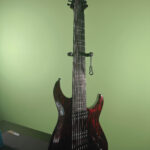🎸 The Ultimate Guide to 50 Guitar Tunings
A comprehensive resource for alternate tunings, creativity, tone shaping, and songwriting exploration.
Introduction
Alternate guitar tunings unlock entirely new musical worlds. They change the instrument’s resonance, unlock fresh chord shapes, create new moods, and inspire riffs and songs you’d never invent in standard tuning.
This is a complete guide to 50 tunings — from the classics to the obscure — each explained in clear language with practical uses and genre recommendations. Use this as a reference, a songwriting tool, or a place to spark new ideas.
1. Standard – E A D G B E
The foundation tuning used across nearly all modern guitar styles. Balanced tension and universal chord shapes make it ideal for learning, improvising, and general performance.
2. Drop D – D A D G B E
Lowering the low E to D provides powerful one-finger chords and deep resonance. Popular in rock, grunge, metal, and fingerstyle.
3. Double Drop D – D A D G B D
Both E strings drop to D, producing rich suspended voicings and ringing drones. Excellent for folk and acoustic storytelling.
4. DADGAD – D A D G A D
A modal Celtic tuning with endless drone potential. Famous for its mysterious, open sound.
5. Open D – D A D F# A D
Forms a D major chord when strummed open. Great for slide guitar, blues, and resonant acoustic playing.
6. Open E – E B E G# B E
Bright version of Open D, tuned a whole step up. Often used for electric slide guitar.
7. Open G – D G D G B D
A staple of blues, roots, and classic rock (Keith Richards). Strong midrange and expressive voicing.
8. Open A – E A E A C# E
Similar to Open G but higher in pitch. Excellent for bright acoustic textures and slide.
9. Open C – C G C G C E
Cinematic, deep, and massive. A favorite of modern fingerstyle and post-rock guitarists.
10. Open C6 – C A C G C E
Warm and jazzy with a built-in major 6 sound. Great for chord melody and expressive acoustic lines.
11. Open Cmaj7 – C G C G B E
Dreamy, modern, and harmonically rich. Ideal for ambient, R&B, and pop styles.
12. Open Csus2 – C G C G D G
Soft, suspended character. Excellent for meditative or world-inspired compositions.
13. Open B – B F# B F# B D#
Low and warm, suitable for baritone-range guitars and thick atmospheric chords.
14. Open Bb – Bb F Bb F Bb D
Mellow and deep. Used for blues slide and mellow acoustic textures.
15. Open D Minor – D A D F A D
Automatically produces a D minor chord. Emotional, dark, and cinematic.
16. Open G Minor – D G D G Bb D
A moody minor variation of Open G used for blues and noir acoustic vibes.
17. Nashville Tuning (High Strings) – E A D G B E
Requires ultra-light strings; low four strings are tuned an octave high. Creates shimmering 12-string-like layers.
18. Half-Step Down – Eb Ab Db Gb Bb Eb
A rock standard, used by Hendrix, SRV, and countless others. Warmer tone and looser feel.
19. Full-Step Down – D G C F A D
Darker and heavier than standard. Perfect for grunge, punk, and thick rhythm tones.
20. Drop C – C G C F A D
Huge in metal and metalcore. Deep low-C combined with familiar chord shapes.
21. Drop B – B F# B E G# C#
Massive tone with tight low-end articulation. Used in modern prog and heavy rock.
22. Drop A# – A# F A# D# G C
Lower than Drop B. Great for gritty sludge, stoner rock, and dark metal riffs.
23. Drop A – A E A D F# B
Essentially a 7-string tuning on a 6-string guitar. Perfect for djent and modern progressive metal.
24. Drop G# – G# D# G# C# F A#
Extremely low. Ideal for ultra-heavy chugs and atmospheric metal.
25. Open F – F A C F C F
Warm and rich. A favorite for folk, Hawaiian-influenced music, and alternate acoustic songwriting.
26. Open F Minor – F C F Ab C F
Eerie and emotional. Useful for dark folk, cinematic work, and minor-key slide.
27. C Standard – C F Bb Eb G C
Iconic for stoner rock and doom. Thick, slow, and heavy.
28. B Standard – B E A D F# B
A tuning used on baritone guitars. Perfect for chord clarity at low pitches.
29. A Standard – A D G C E A
Incredibly deep and resonant. Excellent for drone-based playing and heavy riffing.
30. New Standard Tuning – C G D A E G
Developed by Robert Fripp. Wide intervals allow piano-like note separation.
31. Modal D – D A D G A D
A bright, uplifting modal tuning similar to DADGAD. Simple but musically broad.
32. D Modal Minor – D A D G A C
Adds a minor 7 flavor. Great for haunting and emotional acoustic styles.
33. Open D5 – D A D A D A
Pure power-chord tuning. No major or minor tonality.
34. Open G5 – D G D G D G
A major-less tuning ideal for drones, ostinatos, and repeating riffs.
35. Open C5 – C G C G C G
Huge resonant tuning. Great for metal, soundscapes, and minimalistic riffing.
36. Open Cadd9 – C G C G D E
Modern, bright, and popular in acoustic pop and worship styles.
37. Open Gsus4 – D G D G C D
Suspended and floating. Great for unresolved emotional progressions.
38. Open Dsus4 – D A D G A D
Similar to Modal D. A rich folk-style suspended tuning.
39. Fripp NST Variant – C G D G A E
A modified New Standard designed for flexible melodic work.
40. Orkney Tuning – C G D G C D
A well-known Celtic tuning. Deep low-end and shimmering highs.
41. Dead Man’s Tuning – D D A D F# A D
Traditional with doubled low strings. Creates a built-in chorus effect.
42. Bruce Cockburn Tuning – D A E A E E
A unique tuning used by the Canadian songwriter. Very resonant and expressive.
43. D-Tuned Baritone Variant – A E A D E A
Designed for deep acoustic tones without sacrificing clarity.
44. C Baritone Drone – C G C F C F
Dark and powerful. Great for slow, evolving chord patterns.
45. Low C Drone – C G C D# G C
Blend of drone and dissonance. Used in experimental and alternative metal.
46. Cross-D Tuning – D A D A D D
Banjo-influenced tuning. Works beautifully for folk and bluegrass-style guitar.
47. High C – C F C F C E
Bright and chime-like. Excellent for counter-melodies and polyphonic playing.
48. G6 – D G D G B E
Adds a natural 6th for smooth jazz-like voicings.
49. Gmaj7 – D G D F# B F#
Modern and elegant, great for clean chords and ambient playing.
50. D Minor Pentatonic – D A C G C D
A tuning built around the D minor pentatonic scale. Amazing for slide, blues, and expressive soloing.
Quick Reference Table (All 50 Tunings)
1. Standard – E A D G B E
2. Drop D – D A D G B E
3. Double Drop D – D A D G B D
4. DADGAD – D A D G A D
5. Open D – D A D F# A D
6. Open E – E B E G# B E
7. Open G – D G D G B D
8. Open A – E A E A C# E
9. Open C – C G C G C E
10. Open C6 – C A C G C E
11. Open Cmaj7 – C G C G B E
12. Open Csus2 – C G C G D G
13. Open B – B F# B F# B D#
14. Open Bb – Bb F Bb F Bb D
15. Open Dm – D A D F A D
16. Open Gm – D G D G Bb D
17. Nashville – E A D G B E (high strings)
18. Half-Step Down – Eb Ab Db Gb Bb Eb
19. Full-Step Down – D G C F A D
20. Drop C – C G C F A D
21. Drop B – B F# B E G# C#
22. Drop A# – A# F A# D# G C
23. Drop A – A E A D F# B
24. Drop G# – G# D# G# C# F A#
25. Open F – F A C F C F
26. Open Fm – F C F Ab C F
27. C Standard – C F Bb Eb G C
28. B Standard – B E A D F# B
29. A Standard – A D G C E A
30. NST – C G D A E G
31. Modal D – D A D G A D
32. D Modal Minor – D A D G A C
33. Open D5 – D A D A D A
34. Open G5 – D G D G D G
35. Open C5 – C G C G C G
36. Open Cadd9 – C G C G D E
37. Open Gsus4 – D G D G C D
38. Open Dsus4 – D A D G A D
39. NST Variant – C G D G A E
40. Orkney – C G D G C D
41. Dead Man’s – D D A D F# A D
42. Bruce Cockburn – D A E A E E
43. Baritone Variant – A E A D E A
44. C Drone – C G C F C F
45. Low C Drone – C G C D# G C
46. Cross-D – D A D A D D
47. High C – C F C F C E
48. G6 – D G D G B E
49. Gmaj7 – D G D F# B F#
50. D Minor Pentatonic – D A C G C D
🎧 Styles That Benefit Most From Alternate Tunings
✔ Stoner rock / doom metal
Low tunings (C Standard, Drop B, A Standard) = thick, warm, fuzzy.
✔ Acoustic fingerstyle
DADGAD, Orkney, Open C tunings = angelic harmonics & drones.
✔ Songwriters
Double Drop D, Open G, Open D = new ideas instantly.
Whether you’re chasing heavier riffs, richer acoustic textures, or fresh songwriting inspiration, these 50 tunings offer a lifetime of new sounds to explore. Each one reshapes the guitar’s voice in its own way — from subtle variations to dramatic tonal shifts — giving you the tools to break patterns, discover new moods, and expand your creative vocabulary. Keep this guide close, experiment often, and let these tunings open doors to music you haven’t written yet.
Download the PDF here: https://seymoremusic.com/lessons/



